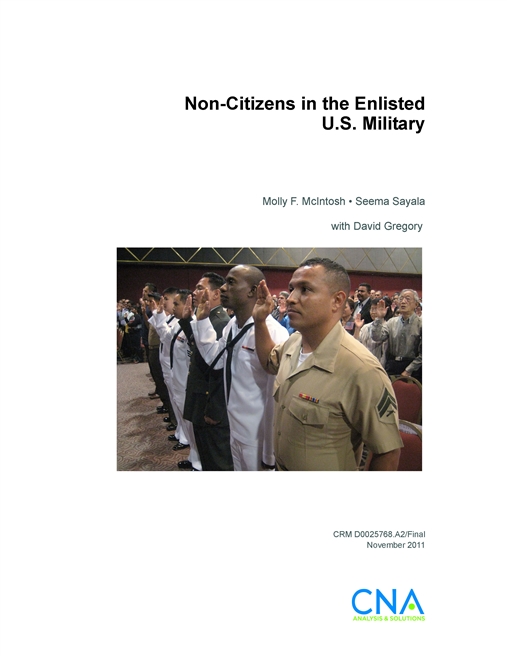Although in recent years non-citizens have made up only a small share of enlisted accessions (roughly 4 percent), they are a potentially valuable pool for enlisted recruiting for three reasons. First, the number of U.S. non-citizens who are eligible for enlisted military ser- vice is large. Approximately 1.2 million non-citizens are in the desired age range (18 to 29) and have the requisite education, resident status, and English language ability for enlistment. Second, our data suggest that a sizable share of the recruitable U.S. non-citizen population comes from diverse backgrounds and possesses language and cultural skills that are of strategic interest to the U.S. military. Third, we find that non-citizen recruits are far less likely than citizen recruits to attrite in the first term, even after controlling for demographic and service-related characteristics that likely affect attrition.
Recent policy changes have streamlined naturalization for many non- citizen servicemembers, so it is not surprising that citizenship attain- ment has increased and time-to-citizenship has decreased over time among non-citizen servicemembers. Our empirical analysis of citizen- ship attainment suggests that non-citizens in the Air Force are more likely than non-citizens in the other services to become citizens. In addition, non-citizens who are minorities, female, better educated, married or have dependents, or who score higher on the Armed Forces Qualification Test (AFQT) are more likely to become citizens.
Regarding time-to-citizenship, we find that it is longer for minority non-citizens but shorter for non-citizens who are better educated or have higher AFQT scores. Also, since the July 2002 signing of Executive Order (EO) 13269 (Expedited Naturalization of Aliens and Noncitizen Nationals Serving in an Active-Duty Status During the War on Terrorism), the waiting period for non-citizen servicemembers to apply for citizenship has been reduced from 3 years to 1 day of hon- orable service. In the post-EO period, we find that non-citizens in the Marine Corps have had the longest average time-to-citizenship, followed by the Navy and the Air Force, and finally the Army. In the coming years, unless the Marine Corps starts a basic training natural- ization program, we expect that Marine time-to-citizenship will likely remain high and will likely fall for the other services. Once the nation is no longer at war, however, the EO will expire; unless current law is changed, this will have two implications: (1) the waiting period for non-citizen servicemembers applying for citizenship—and therefore time-to-citizenship—will increase and (2) the impetus behind natu- ralizing at basic training will disappear.
Our analysis produces four important policy implications. We describe these implications in the paragraphs within.
Download reportCleared for Public Release; Distribution Unlimited. Specific authority: N00014-11-D-0323
Details
- Pages: 104
- Document Number: CRM D0025768.A2/Final
- Publication Date: 11/1/2011
